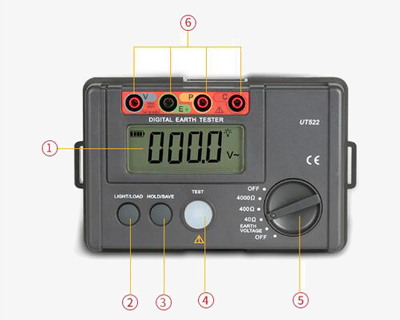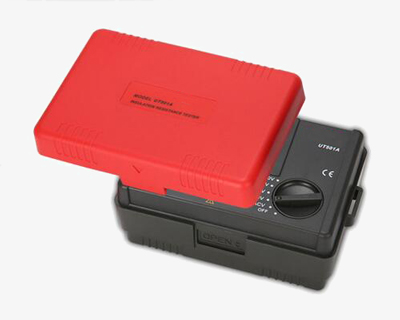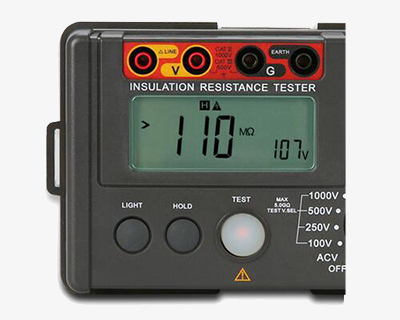Digital ground resistance tester has large LCD display with backlight, which is capable of making precise 3-wire and simple 2-wire earth resistance measurement. The earth testing meter is applied for the earth resistance measurement of grounding systems of various power systems, electrical equipment, lightning protection equipment, etc., and also support AC ground voltage test.

External structure
- LCD display
- LIGHT/LOAD button
- HOLD/SAVE key
- TEST button
- Function selection switch
- Test port

Earth ground resistance tester with sturdy protective cover
When not measuring, the cover can be closed to protect the keys and screen of the insulation resistance tester.

Earth insulation resistance tester with LCD backlight display
The measurement data is displayed with functional symbols, the readings are clear at a glance and high-definition, and the data can be displayed in a backlight.
Applications
The earth ground insulation resistance tester is suitable for measuring the insulation resistance of various electrical equipment and insulating materials such as transformers, motors, cables, switches, electrical appliances, and for maintenance, testing and verification of various electrical equipment.

| Model | SISCO-GRT-UT521 | SISCO-GRT-UT522 | |
| Earth Ground Resistance (Ω) | 0 ~ 20Ω | ±(2%+10) | — |
| 0 ~ 200Ω | ±(2%+3) | — | |
| 0 ~ 2000Ω | ±(2%+3) | — | |
| 0 ~ 40Ω | — | ±(2%+20) | |
| 0 ~ 400Ω | — | ±(2%+3) | |
| 0 ~ 4000Ω | — | ±(2%+3) | |
| AC Earth Voltage (V) | 0 ~ 200V | ±(1%+4) | — |
| 0 ~ 400V | — | ±(1%+6) | |
| Frequency | 50Hz/60Hz | ||
| Features | Display | 2000 counts | 4000 counts |
| Manual range | √ | √ | |
| Auto power off | √ | √ | |
| Low battery indication | √ | √ | |
| Data hold | √ | √ | |
| Data storage | 20 sets | 20 sets | |
| LCD backlight | √ | √ | |
| Full icon display | √ | √ | |
| Double insulation protection | √ | √ | |
| Poor contact display | Display "...Ω" | Display "...Ω" | |
| Over-range display | Display "OL" | Display "OL" | |
| Simple 2-wire testing | √ | √ | |
| Precise 3-wire testing | √ | √ | |
| General | Power supply | 1.5V battery (LR6) x 6 | |
| Display | 70.6mm x 34mm | ||
| Operating temperature | 0℃ ~ 40℃ | ||
| Operating relative humidity | ≤80%RH (non-condensing) | ||
| Operating altitude | ≤2000m | ||
| Storage temperature | -20℃ ~ 60℃ | ||
| Storage relative humidity | ≤75%RH (non-condensing) | ||
| Product weight | 560g | ||
| Product size | 160mm x 100mm x 70.5mm | ||
| Accessories * | Simple test leads with alligator clips, standard test leads with alligator clips, earth spike, batteries, carrying bag | ||
Note: * Batteries are Not Included for air shippment.
Q1: What is a insulation tester?
A1: Insulation tester, also known as megohmmeter or meggers, are widely used to measure cables for generators, motors, power transformers, wiring, appliances and other electrical installations such as control, signal, communication and power ) insulation resistance. They are often used in routine maintenance procedures to indicate changes in the insulation resistance of a motor over months or years. Large changes in insulation resistance may indicate potential failures. Therefore, regular calibration of the megohmmeter is required to ensure that the meter itself has not changed over time.
Q2: What is insulation resistance?
A2: Insulation resistance is the DC resistance of the insulation under the specified conditions, that is, the DC voltage is applied to the dielectric, after a certain period of polarization, the resistance corresponding to the leakage current flowing through the dielectric is called insulation resistance. It is the most basic insulation index of electrical equipment and electrical circuit.
Q3: How to measure insulation resistance?
A3: 1. Connect all the lines according to the method measured by the insulation resistance tester. The connection between the measuring lead and the pipe is more suitable for the use of magnetic joints or clips, and the connection point must be free of rust.
2. The measuring instrument should be a 500V/500MΩ (the error here cannot be greater than 10%) insulation tester. Turn the handle of the megohmmeter to reach the specified speed for 10 seconds. The resistance value indicated by the megohmmeter stably is the insulation resistance value of the insulating joint (flange), which is required to be greater than 10 megohms.
Tips: What should be paid attention to when using an earth ground resistance tester?
- Ground resistance tester working environment: relative humidity ≤75%RH, temperature 0~40℃.
- When connecting or disassembling the DUT, it must be carried out in the "reset" state.
- The connection between the special test line and the ground resistance tester must be in good contact, and both ends of the resistance under test must be clamped. When adjusting the loop current, pay attention to the digital change of the ammeter, and slowly adjust to the required current value.
- After the test is over, press the reset button first, and then return the current to zero. If there is an abnormal situation during the test, press the reset button first, and then quickly return the current to zero.
- Earth resistance testers that are found to be unqualified should stop testing and return them to the laboratory for measurement. Products or components tested within 2 hours should be re-tested with qualified earth resistance testers.
- The earth resistance tester should be measured regularly.
Thank you for buying industrial test and measurement equipment on SISCO.com, all products sold by SISCO and the partner cover a 12 months warranty, effective from the date of receiving the products.
What is covered?
SISCO is responsible for providing free spare parts, and free technical support to assist the customer to repair the defective products until the problem is solved.
What is not covered?
- Product purchased from anyone other than a SISCO store or a SISCO authorized reseller.
- Expendable parts.
- Routine cleaning or normal cosmetic and mechanical wear.
- Damage from misuse, abuse or neglect.
- Damage from use of parts other than SISCO approved.
- Damage from use outside the product’s usage or storage parameters.
- Damage from use of parts not sold by SISCO.
- Damage from modification or incorporation into other products.
- Damage from repair or replacement of warranted parts by a service provider other than a SISCO authorized service provider.
- Damage caused by the application environment not meeting the product usage requirements and the failure to perform preventive maintenance.

